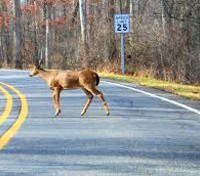Watch for deer crossings! Collisions increase in October-December
Bloomington, Ill. — U.S. drivers are just as likely to have a claim involving a collision with deer, elk or moose than they were last year, according to new claims data from State Farm.
The odds drivers will have a claim from hitting one of those animals is 1 out of 169, the same as it was in 2014. That likelihood more than doubles during October, November and December, when deer collisions are most prevalent.
For the ninth year in a row, West Virginia tops the list of states where an auto insurance claim is most likely to occur. The odds a driver in the Mountain State will have a claim did improve to 1 in 44, up from 1 in 39 in 2014, an 11.4 percent decrease. Hawaii rounds out the bottom of the list also for the ninth year in a row with odds of 1 in 8,765.
The top five states in which a driver is most likely to have a claim from a collision with a deer, elk or moose are:
Rank State 2015 Odds Percent Change from 2014
- West Virginia: 1 in 44; 11.4% less likely
- Montana: 1 in 63; 19.1% more likely
- Iowa: 1 in 68; 13.2% more likely
- Pennsylvania: 1 in 70; 1.4% more likely
- South Dakota: 1 in 73; 12.3% more likely
Injuries, vehicle damage and fatalities all can result from vehicle collisions with deer. In 2013, 191 deaths were the result of collisions with animals, with deer being the animal most often struck, according to the Insurance Information Institute and the Insurance Institute for Highway Safety.
These tips could help drivers avoid a collision:
- Use extra caution in known deer zones.
- Always wear your seatbelt.
- At night, when there is no oncoming traffic, use high beams.
- Avoid swerving when you see a deer.
- Scan the road for deer and other danger signs.
- Do not rely on devices such as deer whistles.
And here are some deer facts that all drivers should know:
- Deer are on all roads.
- Deer are unpredictable.
- Deer often move in groups.
- Deer movement is most prevalent in the fall.
- The hours between dusk and dawn are high risk times.
Whether you live in West Virginia or Hawaii, it’s important that drivers are practicing safe driving habits and watching out for animals on the road. Wearing your seat belt and practicing defensive driving tactics could make a significant difference.
Reasons why odds go up or down in 2015
Deer claim counts rose by more than 21 percent in Indiana and more than 13 percent in Iowa this past year. The top ten states stayed the same from 2014, just in slightly different order.
What causes these significant changes in deer collision rates? “Periods of daily high-deer movement around dawn and dusk as well as seasonal behavior patterns, such as during the October-December breeding season, increase the risk for auto-deer collisions,” said Ron Regan, executive director for the Association of Fish & Wildlife Agencies.
“Changes in collision rates from year to year are a reflection of changing deer densities or population levels; more deer in a given area increases the potential for collision. Deer populations are also affected by conditions such as new or improved roads with higher speeds near deer habitat, winter conditions, and other related factors,” Regan said.
More 2015 State Farm deer collisions facts:
- The national cost per claim average is $4,135, up 6 percent from 2014 ($3,888).
- The months a driver is most likely to have claim involving a deer, elk or moose in the U.S., mostly due to mating and hunting seasons, are: 1. November 2. October 3. December
- Nearly 10 percent of the country’s deer claims occur in Pennsylvania (126,275 collisions), though when taking into account the amount of licensed drivers in the state, West Virginia still edges out as number one with a likelihood of 1 in 44 compared with Pennsylvania’s 1 in 70 (fourth highest ranked state).
Using its claims data and state licensed driver counts from the Federal Highway Administration, State Farm, the nation’s leading auto insurer, calculates the chances of any single American motorist striking a deer, elk or moose during the time frame of July 1, 2014 to June 30, 2015 in all 50 states and the District of Columbia.
The data has been projected for the insurance industry as a whole, based on the State Farm personal vehicle market penetration within each state. The State Farm data is based on comprehensive and collision claims only. Claims involving policyholders with liability insurance coverage only are not included.

